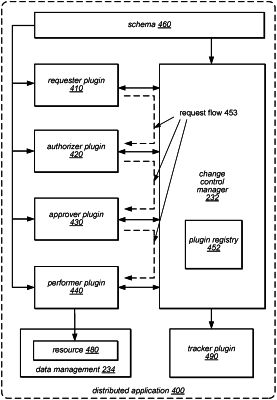| CPC G06F 8/71 (2013.01) [G06F 8/73 (2013.01); G06F 16/2358 (2019.01); G06F 16/244 (2019.01)] | 20 Claims |

|
1. A system, comprising:
a document-based data store, storing a plurality of different application data objects for one or more application features of an application development, build, delivery, and deployment service;
a database, storing a graph that models relationships between the plurality of different application data objects, wherein the database is separate from the document-based data store;
at least one processor; and
a memory, storing program instructions that when executed by the at least one processor, cause the at least one processor to implement a control plane for an application, configured to:
receive a request, via a first plugin for a first development tool that provides a relationship management interface, that specifies within the request a relationship between a first application data object and a second application data object, the request causing a write to implement the specified relationship between the first application data object and the second application data object;
responsive to the receipt of the request:
determine, by a change control management system, that the write can be performed based, at least in part, on one or more requests received via a second plugin for a second one or more development tools;
send a request to perform the write to the database to update the graph in accordance with the specified relationship between the first application data object and the second application data object;
receive a response from the database that indicates successful completion of the write to the database to update the graph;
after receipt of the response from the database, return an acknowledgment of the request via the relationship management interface.
|